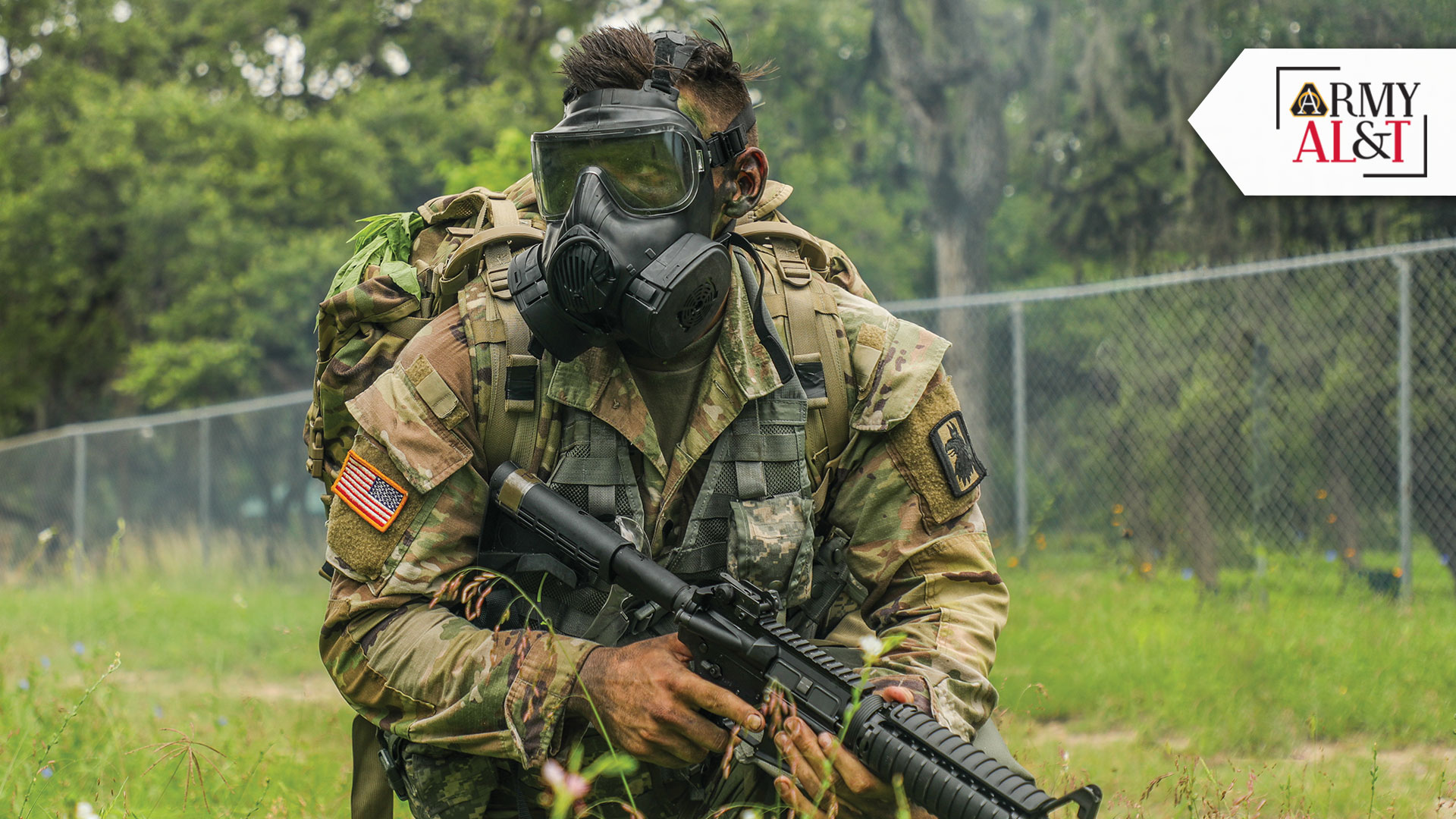
TOTAL COVERAGE: U.S. Army Spc. Justin Earnhart pulls security while wearing a joint service general purpose mask during an exercise in the Army Futures Command Best Warrior Competition on Fort Sam Houston, Texas, June 9, 2021. So-called gas masks are dependent on military grade carbon for their effectiveness. (U.S. Army photo by Pfc. Joshua Taeckens)
How DEVCOM is qualifying additional sources to supply military-grade carbon for use in gas masks and large-scale protective filters.
by Brian B. Feeney, Ph.D.
The protective air filter on a gas mask, or a protective filter on a vehicle or building, can be all that stands between the warfighter and a deadly chemical agent that an enemy force might use in battle. That means that the filter’s carbon—the active mechanism in capturing the chemical agent—must meet the DOD’s exacting specifications and be available in the quantities that the force needs.
For 80 years, the DOD relied on just one supplier, Calgon Carbon Corporation, in Pittsburg, Pennsylvania, with just one carbon production line for this critical life-protecting material. That represented a serious supply chain vulnerability. Now, the DOD is on its way to having double the supply and a second supplier, Molecular Products, Inc., headquartered in Louisville, Colorado. That second supplier was achieved through innovative acquisition and teamwork.
The Combat Capabilities Development Command Chemical Biological Center (DEVCOM CBC) joined forces with the Joint Program Executive Office for Chemical, Biological, Radiological and Nuclear Defense (JPEO-CBRND) and several other defense agencies to create a new and better standard for military-grade carbon.
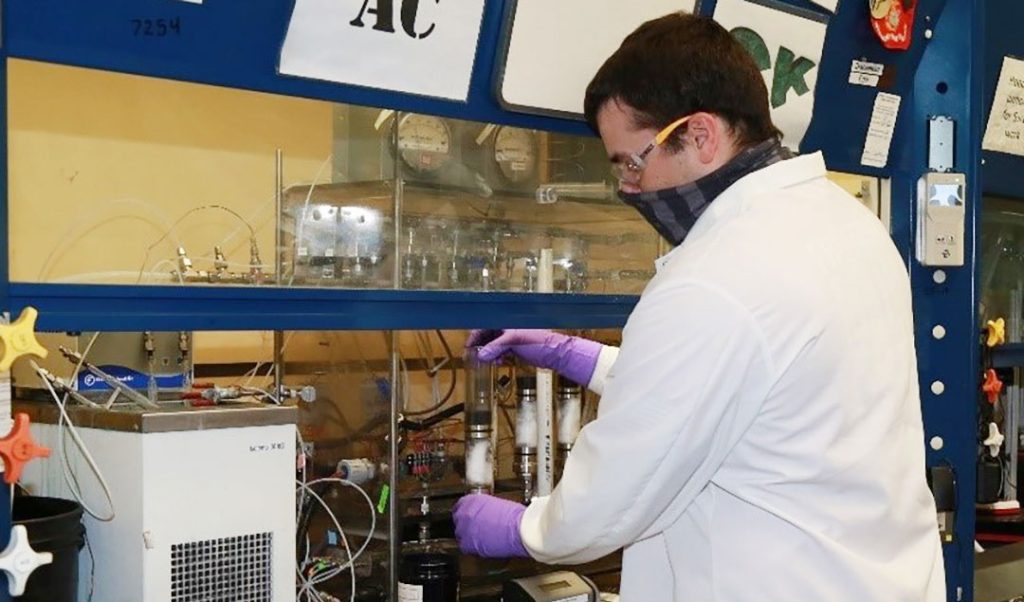
TUBE TIMING: Aaron Salgado, a DEVCOM CBC chemist, places a tube containing a layer of carbon into a testing system that will analyze the time it would take a chemical agent to break through it. (Photo by Dr. Brian Feeney, DEVCOM CBC)
A LONG ROAD
In 1992, DOD replaced the chromium-containing carbon it had used for 50 years with a safer but harder-to-obtain carbon for protective masks and filters. It was very effective for removing cyanide but was found to be a carcinogen. That effectiveness could be retained with a safer but harder-to-obtain carbon, known as ASZM-TEDA, which is an initialism for the ingredients embedded in it as part of the supplier’s manufacturing process.
These metals are less toxic and safer for the user than chromium. Center scientists worked with Calgon to develop the new formulation. The problem was that only Calgon had the ability to mine the material and to treat it with this mix of metals.
But first, to fully understand the challenge of obtaining a second supplier of military grade carbon, an explanation of raw carbon, and the processing it must undergo to get to military grade, is needed.
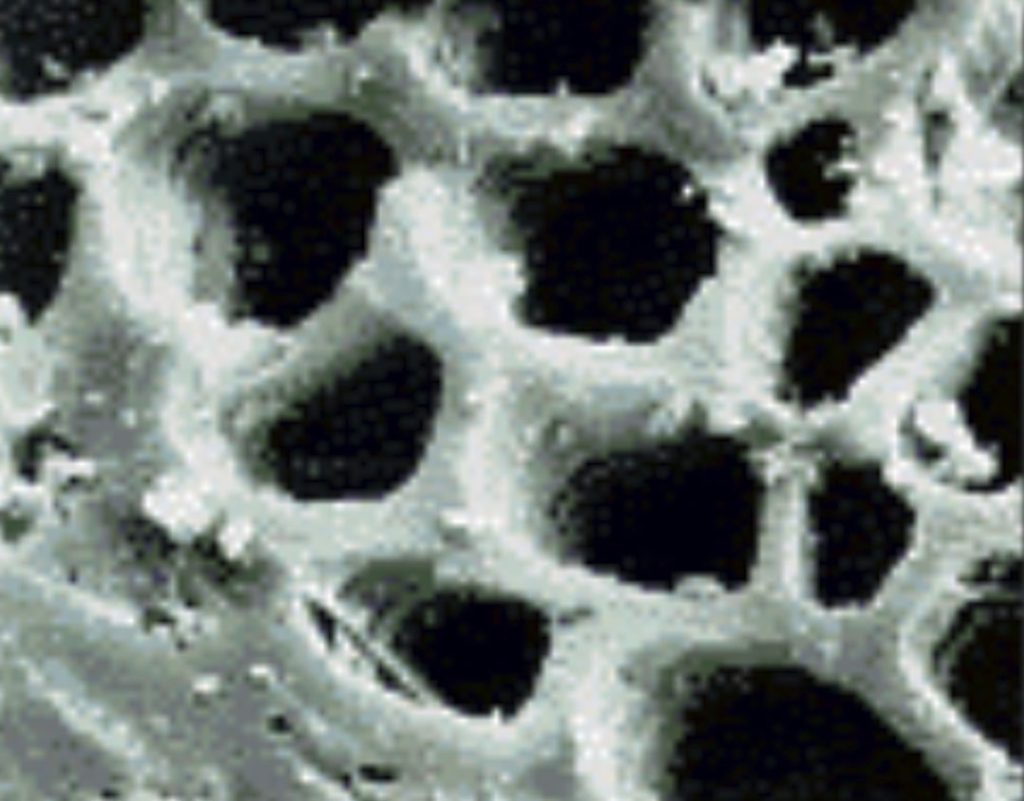
CARBON COMPOSITION: The pore structure inside activated carbon is so complex that one gram has a surface area of greater than 1,000 square meters. (Photo courtesy of Molecular Products, Inc.)
RAW TO READY
Carbon is such a complex subject that it has its own branch of study: organic chemistry. While only 0.025 percent of the Earth’s crust contains carbon, it is integral to all plant and animal life on the planet, and in its crystalline form it is a girl’s best friend—a diamond. Because it is mined from the ground, it is readily available to manufacturers of gas masks and filters. Once mined, raw carbon goes through several processing steps to be turned into a granular porous substance capable of adsorbing and neutralizing toxic chemicals with remarkable efficiency.
Carbon mined from the ground is the raw ingredient for gas masks and collective protection filters because it is primarily an amorphous carbon, meaning that it does not have a crystalline structure, as with diamonds and graphite. Instead, it contains a mixture of volatile components—materials that readily change to vapor—that are removed by heating it up in a reduced oxygen environment.
The resulting product, referred to as activated carbon, contains an extensive network of pores with dimensions ranging from 0.2 to 100 nanometers. A human hair is approximately 90,000 nanometers wide. Because of how minute these pores are, one gram of activated carbon has a surface area of greater than 1,000 square meters.
This maze of micropores creates a topology that is ideal for rapid mass transport and adsorption of low vapor-pressure toxic chemicals. But additional removal capability is needed. To add that, scientists impregnate the carbon with the metals copper, silver, sodium and molybdenum, represented by the initials ASZM, plus triethylenediamine, commonly referred to as TEDA. While the pores trap the toxic chemicals, the four metals plus TEDA bind and decompose toxic gases by breaking up their chemical bonds. Center scientists found that TEDA, most commonly used as a catalyst for manufacturing polyurethane foam and curing epoxy resin, is effective at neutralizing certain cyanide chemicals and even the nuclear byproduct radioactive methyl iodine.
The actual carbon impregnation occurs by mixing the metal salts with water and ammonia hydroxide. The solution is then added to the carbon, which is heated gradually to about 375 degrees Fahrenheit. When the dried ASZM carbon product cools down, granular TEDA is added, which sublimes—switches from the solid state to a gas, and then condenses again as a solid without passing through the liquid state—and is adsorbed in the pores of the activated carbon.
This is the military grade carbon that Calgon and Molecular Products put into a drum and ship out to the protective mask and filter manufacturers who supply our military forces. There, the carbon is poured from the drums into individual filter containers in a granular form. Samples are selected at random from these deliveries and sent to DEVCOM CBC where scientists perform breakthrough testing using live chemical agent to ensure that they meet the military specifications.
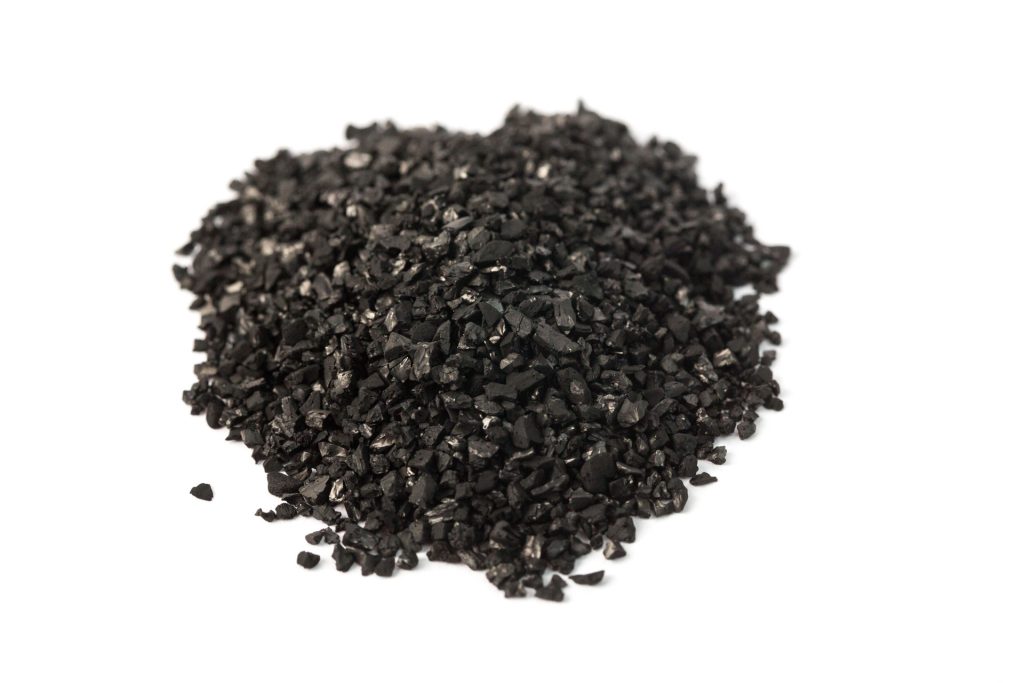
EARTH ESSENTIALS: Only 0.025 percent of the earth’s crust contains carbon, yet it is integral to all plant and animal life on the planet. (Photo courtesy of Molecular Products, Inc.)
TEAM SEARCH
Calgon Carbon approached DOD in the late 2000s about supporting a supply expansion, and in 2012, DOD assembled a team to solve the problem. It launched a project it called Activated Carbon Capability Expansion, or ACCE, under the Defense Production Act Title III Office. The project’s mission was to qualify additional sources to supply military-grade carbon for use in gas masks and large-scale protective filters. The project’s first task was to set up a team consisting of carbon filter experts largely drawn from scientists and engineers at JPEO-CBRND who specialize in this area. Once stood up, the team went straight to the DEVCOM CBC for its expertise in protective carbon testing. The center had established the original qualifying standard for ASZM-TEDA in the late 1980s.
That standard is known as MIL-DTL-32101, and it was relied upon to test the sole supplier’s carbon from 1992 on. The team of carbon filter experts had originally hoped to go on using it, without change, as the standard for qualifying any new suppliers. However, when they found a second supplier and awarded a contract to it in 2016, the experts at the center advised against it because the standard does not accommodate a second supplier.
WE’RE GOING TO NEED A BIGGER STANDARD
“We had to tell them that, no, 32101 alone is not enough to qualify a second supplier,” said Lowry Brooks, acting deputy director of engineering at DEVCOM CBC. “That standard had been in use since 1992 because all the carbon came from the same supplier, mining the same material from the same mine, impregnating the carbon with the same metals in the same way.”
Brooks and his team persuaded the Title III Office carbon-filter team that with an additional carbon source, none of those steps would be performed exactly the same way. A more comprehensive qualification standard would be needed to make sure all DOD specifications were met. The center formed a multi-disciplinary team of its in-house experts that worked overtime to meet a strict DOD deadline to develop a better standard. The result was the classified MIL-DTL-32101B.
While this was a significant accomplishment, it was clear that further improvements to the specification were required to confidently qualify new carbon suppliers. The updated specification was more comprehensive, but it still relied heavily on limited historical data points. The team needed to get up-to-date data through current live agent tests. But that would take more funding.
The center persuaded the Title III Office carbon-filter team that because protective carbon is a life-supporting material, it was vital to base the standard on current testing. The standard also had to be expanded to include chemical threats that have emerged since 1992. In addition, the center needed to calculate the shelf life of protective carbon material under tropical, desert and arctic conditions using the latest testing equipment, which the center has.
The alternative—relying on old, less comprehensive data—would not have qualified the new supplier with enough confidence that the carbon could adequately protect warfighters on the modern battlefield without up-to-date real-world testing. Adding to the necessity of this was the fact that Calgon decided to create a second production line, which, as with any additional production line in any industry, is not entirely identical to the earlier version.
The more expensive path turned out to be the only path, and the center collaborated with ACCE, JPEO-CBRND and U.S. Army Tank-Automotive and Armaments Command (TACOM) to secure funding for the center to perform a year-long study.
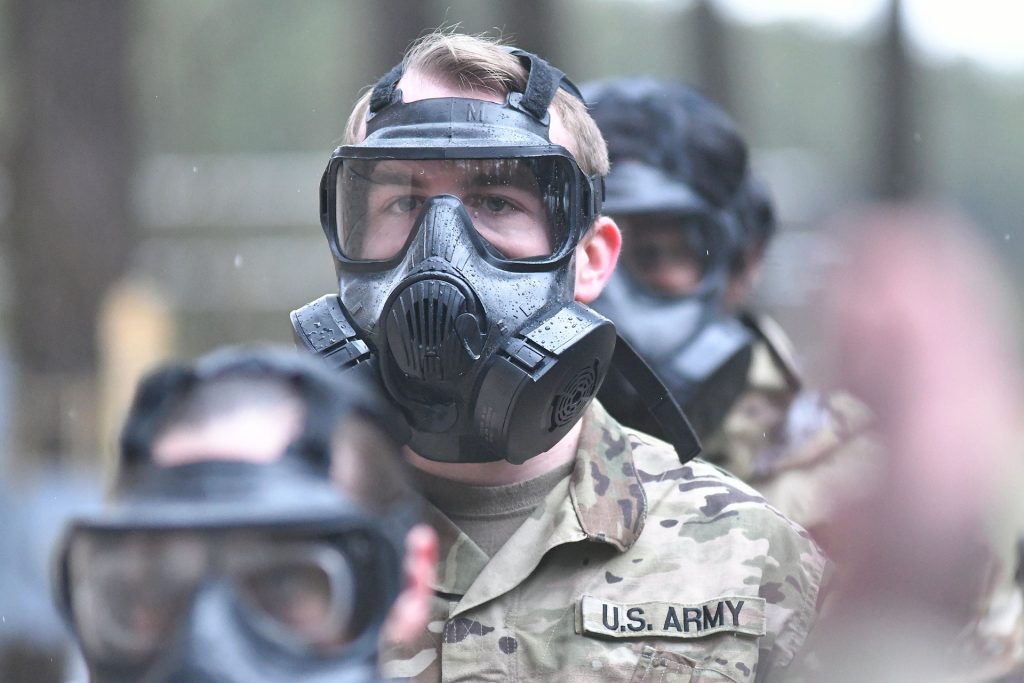
HIGHER STANDARDS: DEVCOM CBC, working with several of its defense agency partners, developed a new standard that quadrupled the nation’s production capacity for military grade carbon to go into protective masks and filters, ending 30 years of reliance on a sole supplier. (Photo by T. Anthony Bell, U.S. Army Garrison Fort Lee Public Affairs)
TEAM OF EXPERTS
The center’s interdisciplinary team performed the necessary testing and established a current data set over the course of 2018. In 2019, they started updating the specifications for MIL-DTL-32101B using this new trove of data. The architect for all this was Ryan Bearekman, the center’s program manager for the effort. “The work spanned a lot of areas and disciplines,” said Bearekman. “We needed chemists who could design and perform tests to challenge the carbon using a wide range of live chemical agents. And, we needed people trained in how to stress the carbon in our unique environmental chambers that simulate arctic, desert and tropical conditions.”
Bearekman also needed engineers who understood the supply chain and experts in quality control and quality assurance of materials. He got both from the center’s Rock Island, Illinois research campus. “The Sustainment Engineering Protection Branch provided the experts who were the real authors and architects of MIL-DTL-32101B. They have been working on military specifications for decades and knew exactly how to codify them so that they would be understandable to all.” Bearekman said.
A key feature of the new standard is that it is based on detailed measurements of the length of time it takes for agents to break through the carbon. Different chemical agents take different lengths of time to break through a carbon layer and render it no longer protective. Other variables that need to be measured are the breakthrough times of each agent at different carbon-bed thicknesses and airflow velocity.
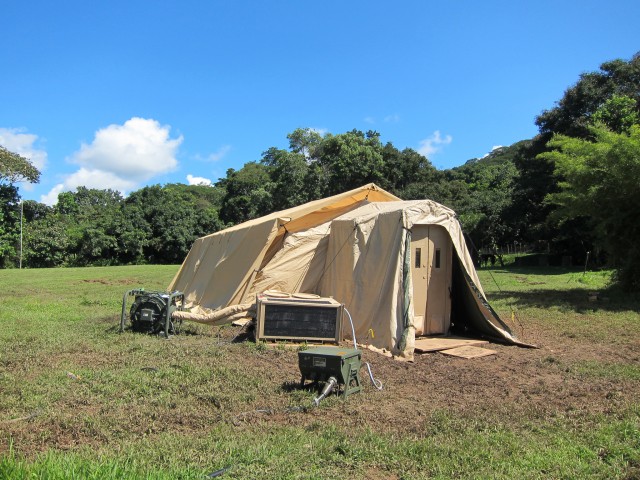
CRITICAL COVER: The U.S. Army’s Joint Expeditionary Collective Protection tent is 43 feet long and protects up to 15 occupants from a chemical-biological agent. (Photo by U.S. Army)
|
GIMME SHELTER: COLLECTIVE PROTECTION Military protective masks, or “gas masks,” appear in everything from news stories to Hollywood movies. Less well known is “collective protection.” This kind of chemical-biological threat protection is designed to protect a group of people inside a tent, building, armored vehicle, aircraft and even a naval vessel.Instead of one carbon filter housed inside a protective mask, collective protection systems consist of a series of filters arrayed inside a much larger container that attaches to a vehicle or structure. Any air entering the protected space must pass through it, and any toxic gases are captured by the bank of carbon filters.The U.S. Army first started developing collective protective systems in the mid-1960s, and their use has steadily increased within the U.S. military since then. Now, virtually every combat vehicle being designed for future use includes some form of collective protection.In 2015, the U.S. Army introduced the Joint Expeditionary Collective Protection tent. It is 43 feet long, 13 feet wide and 7 feet high erected, and can house 12 to 15 people. It can house command and control, aid stations or other critical functions. It is one of a family of chemical-biological protection shelters currently under development. Protective masks will always play a crucial role in protecting individual warfighters in the battle space, but collective protection systems are likely to keep growing in capacity and find ever-new applications. |
CONCLUSION
DOD accepted the updated standard, now known as MIL-DTL-32101Bw/AMD2 as the official standard in 2020. It uses the new data to pass or fail batches of carbon material with a high degree of confidence so that users of protective masks and filters know they will be safe.
The new standard was used to qualify Molecular Products, Inc. It now has two production lines in operation at its Louisville, Colorado facility and is finalizing the qualification of its second line after getting the first line approved in March 2021.
The new standard will also be used to qualify a second facility for the long-time sole supplier, Calgon Carbon, Inc., which it plans to open in Bay St. Louis, Mississippi. Their original facility near Pittsburg will continue production, too. The diversity of operating locations provides DOD with security against losing capacity due to natural disasters.
Having two suppliers and four manufacturing lines means that the nation will have four times the production capacity for military grade carbon for masks and filters. Having a more certain supply of a material that is vital for keeping warfighters safe is a comforting feeling, according to Keith Scheffler, the Title III Office’s executive agent for the effort and a project manager at the Air Force Research Laboratory. “This is an acquisition success story. We now have supply chain redundancy, which is how you ensure the stability of the industrial base and better assist the warfighter.”
This expanded capacity is truly a national security benefit, according to Brooks. “For 30 years we were only one factory fire away from a complete supply disruption. For something as vital as respiratory protection for our warfighters, that had to change. And, by working together as a team with JPEO-CBRND, TACOM and the Title III Office, it did.”
For more information, go to https://www.cbc.devcom.army.mil/.
BRIAN B. FEENEY, Ph.D., is a public affairs specialist at the U.S. Army Combat Capabilities Development Command Chemical Biological Center where he writes news and feature stories on the science and engineering achievements of the center’s researchers. He has written for the center since 2014, and wrote stories, fact sheets and strategic communications plans for the U.S. Army Chemical Materials Activity, and the U.S. Army Environmental Command, since 2000. He holds a Ph.D. in risk communication from Temple University, an M.A. in communications from Cornell University, and a B.A. in history from Colorado College.







